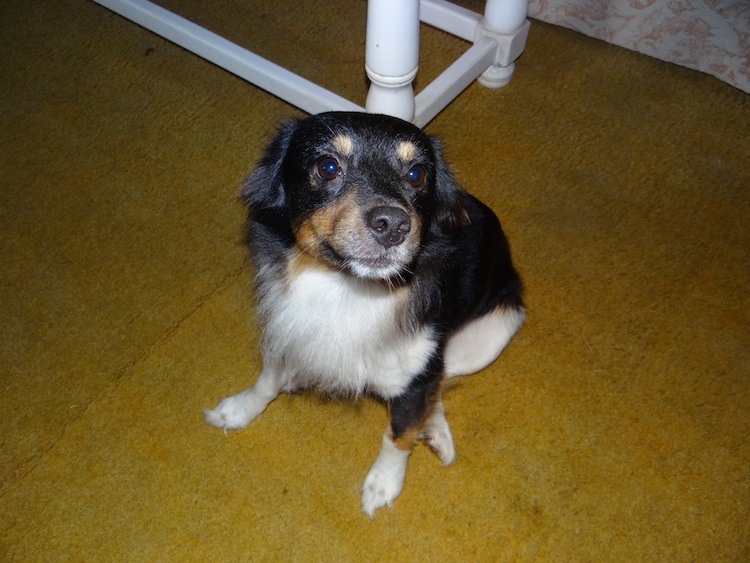As I was outside watering my newly installed shrubs this morning, out of the corner of my eye I saw a black and white streak go tearing across the yard. It was my rat terrier acting like he was having a conniption fit as he writhed and snapped at his back.
My collie was laying at the bottom of the barn ramp in the sun. Then, she too began to squirm and bite at herself as she got up and moved off.
I called fruitlessly for Baboo, the terrier; he wasn’t responding. I finally found him at the back patio with his tail tucked under, shaking. He had part of a yellow jacket stuck to his back and must have ingested some since he was retching . Indoors, Baboo hightailed it up the stairs to hide. Cara, the collie began to pace around from room to room. She was shedding yellow jackets out of her thick fur coat where they had entangled themselves. It took most of the rest of the afternoon for them to recover, with me combing hornets out of hair and taking them on walks to get their minds off the ordeal. Baboo was hyper-sensitized–even buzzing stinkbugs made him leap onto my lap and up to the back of the chair.
This particular species of yellow jacket were ground dwellers. I found their large hole near my poultry yard where Baboo must have disturbed them since there were quite a few very agitated hornets clinging to plants nearby. When one is squashed, they can emit a pheromone that riles up the colony which goes into hyper protective mode. Hornets may mark a target with a pheromone and track it with reinforcements which is why Baboo was running full tilt and unsuspecting Cara was getting drilled by determined stingers.
Both dogs are dark colored, which sources claim agitates yellow jackets since that is the tone of their natural predators (skunks, bears). Then again, they also get agitated by the smell of sweaty bodies and become over attracted by bright colors and floral scents!
My general philosophy for most life is “live and let live”. When it comes to stinging insects, unless they are a hazard in an area where I regularly work and travel, I just ignore them or give them a wide berth. Or hope the neighbor’s guinea fowl will find the pesky hornet nest and eat them. Most of the gardening year, we don’t intersect directly and I just watch their activity on the plants. Yellow jackets are actually quite beneficial: as predators they may feed their colonies a good two pounds worth of insects including caterpillars, flies, aphids, mosquitos and spiders over the summer, liquifying them to feed their young. Later in the season, sugary foods are a strong attractant–ripe fallen fruit, nectar (and your soda) to condition the new queens in the colonies. By fall, this quest for sweets and the large number of “unemployed worker hornets” makes them obnoxious hazards to outdoor enjoyment. However, come the cold weather, these hundreds of workers will perish leaving only a queen who will secrete herself in a safe location over the winter. The nest, constructed of a paperlike substance, in this species case, underground, will be abandoned by the queen although a new one may be constructed nearby the following year.
There are times in which removing/discouraging the yellow jackets is the wisest course for humans and animals. Look for a convergence of hornets in one area and watch for a “bee line” as they take turns entering a hole. The colonies can become very large, which may require professional assistance. Yellow jackets don’t fly readily at dark, but beware–they can still instantly mobilize for an attack, especially if a light is used. Recommendations are to apply an insecticide dust which will adhere to bodies as they travel in and out of the nest, use an aerosol spray or cover the nest with a large clear glass bowl. Once the nest is cleared either by natural seasonal attrition or by the means listed above, care should be taken to close it off to future occupancy by a new queen.
Here is a video I took of the nest whose colony attacked the dogs:







2 comments for “Yellow Jacket –A Temperamental Mascot”